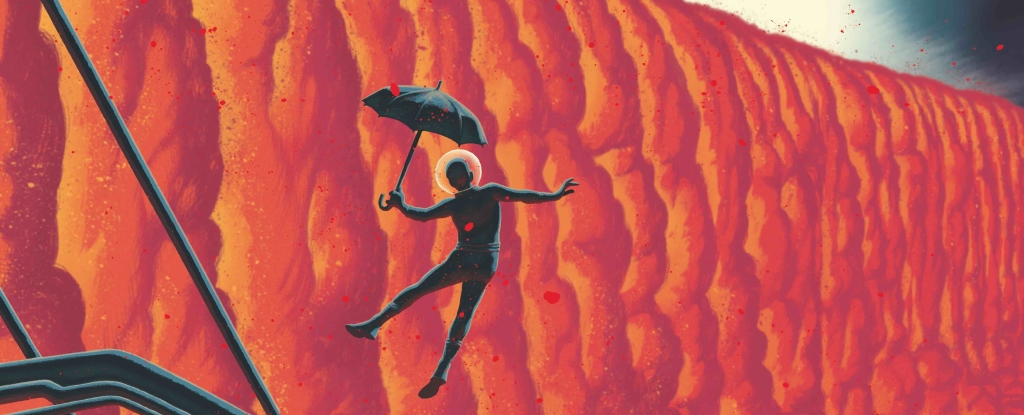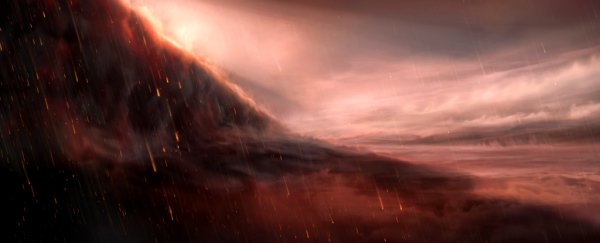In the constellation of Pisces, 640 light-years from Earth, sits a hell-planet.
The gas giant WASP-76b whips around its star at a breakneck orbit of just 1.8 days, and those days are brutal, with temperatures in excess of 2,400 degrees Celsius (4,350 Fahrenheit) - hot enough to vaporise iron.
But where day turns to night, the temperature cools enough for the iron vapour to condense again into scorching liquid that then rains down towards the planet's interior, according to a new study.
"One could say that this planet gets rainy in the evening, except it rains iron," said astrophysicist David Ehrenreich of the University of Geneva in Switzerland.
WASP-76b, whose discovery was announced back in 2016, is a type of planet known as a hot Jupiter. It's a smidge less than the mass of Jupiter, but more bloated and fluffy, around 1.8 times Jupiter's size.
 Comic-book-style illustration showing the evening border of WASP-76b.(Frederik Peeters)
Comic-book-style illustration showing the evening border of WASP-76b.(Frederik Peeters)
It's also only about 5 million kilometres from its star, which is both larger and hotter than our Sun - 1.5 times the Sun's mass, 1.8 times the size, and with a temperature of around 6,329 Kelvin (the Sun is 5,778 Kelvin).
So, not only is the exoplanet subject to scorching radiation thousands of times greater than Earth's irradiation from the Sun, it's also tidally locked. This is when one side of an orbiting body always faces the object it is orbiting - for a nearby example, the Moon is tidally locked with Earth.
In the case of WASP-76b, this means one side is in perpetual day, and the other in perpetual night, with a significant temperature difference between the two. The day side is around 2,400 degrees Celsius (4,350 Fahrenheit), and the night around 1,500 degrees Celsius (2,730 Fahrenheit).
This isn't the hottest exoplanet ever discovered - that crown is being worn by KELT-9b, an exoplanet so hot it's literally evaporating - but it's definitely more on the extreme end of the scale.
Modelling has suggested that, on planets like WASP-76b, the extreme temperature difference between the two sides should generate strong winds. This, and the planet's rotation, should push iron vapour around the planet, and atoms on the day side should recombine into molecules on the night side.
However, evidence supporting this expectation - a chemical gradient, for instance - has not been acquired. So Ehrenreich and his team decided to take a closer look. Specifically, they wanted to study the terminators - the lines between night and day - to see if these displayed asymmetrical chemistry. This, too, would support the metal rain theory.
They used high-dispersion spectroscopy to analyse the light around the edge of the planet, looking for signatures in the spectrum that indicated an element was blocking some of the light. And they found it. On the evening terminator - where day turns into night - they found a strong signature of iron vapour.
On the morning terminator - where night turns to day - this signature was absent. This is pretty strong evidence in support of iron rain, since liquid iron is the most stable high-temperature iron-bearing condensate.
"The observations show that iron vapour is abundant in the atmosphere of the hot day side of WASP-76b," said astrophysicist María Rosa Zapatero Osorio of the Centre for Astrobiology in Spain.
"A fraction of this iron is injected into the night side owing to the planet's rotation and atmospheric winds. There, the iron encounters much cooler environments, condenses, and rains down."
Then, because the iron has rained out of the upper atmosphere, it does not reappear as vapour on the morning terminator.
Now that the team's observations have returned a result, it may be possible to take similar observations of other hot Jupiters, looking for signs of metal rain. And, of course, everyone has high hopes for the high-tech James Webb Space Telescope's ability to peer into the atmospheres of different exoplanets. It's due to launch next year.
Astronomers have already identified exoplanets with clouds of corundum - the building block of rubies and sapphires - and another that has iron clouds. We can't wait to see what other wacky weather is out there in the Universe.
The research has been published in Nature.
